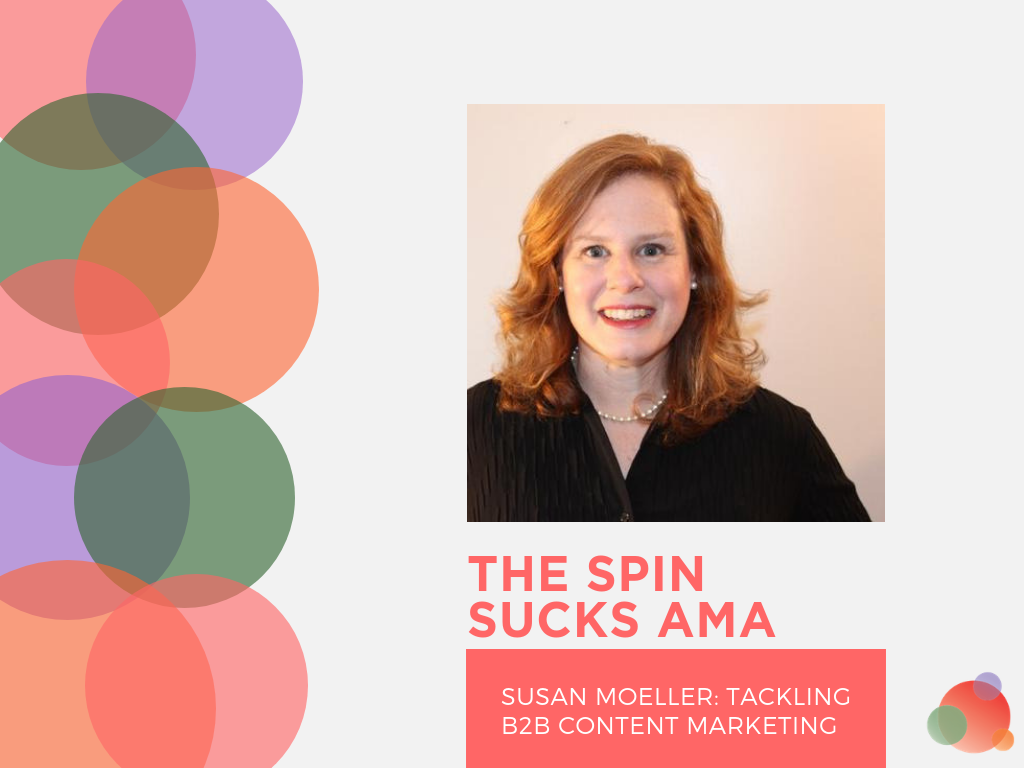 B2B content marketing is tricky.
B2B content marketing is tricky.
For one thing, the product or service you’re trying to promote, isn’t usually what most people consider exciting.
And that makes storytelling a challenge.
Lucky for us, Susan Moeller from BuzzSumo stopped by as a guest on our most recent #SpinSucksAMA.
Not long ago, she wrote a great blog post about how we don’t always have to tell a story with B2B content.
Sometimes the facts are all we need.
That doesn’t mean your article should be dull and boring.
You can create lively and informative how to tips, designed to help your audience.
We had a lively AMA, but for those who didn’t get to join us, here’s a quick recap.
Meet Susan Moeller
Susan is the senior marketing manager at Buzz Sumo and co-founder of the Women in Content Marketing Facebook group.
She’s also the smarty pants behind the BuzzSumo Academy.
Susan knows her stuff when it comes to B2B content.
She’s knowledgeable, entertaining, and kept the community engaged.
Setting the Stage
Susan started us off with a short presentation on what’s working well in the B2B content world right now, and the type of content that keeps people coming back.
She analyzed the data of 52,892 B2B content pieces, published on B2B websites, and used a list of B2B terms to identify the content. (If that isn’t business focused, what is?)
Next, she looked for what we can learn from the extraordinarily high performing pieces.
One of the key takeaways? Practicality is key!
Susan said:
A lot of what performs well for a B2B audience is very practical. It also has practical headlines, so it needs to both be practical and clearly signal that it’s practical. And it’s success-focused, so in looking at the best performing—and by best performing, I mean the most socially engaging B2B content from the past year—these were the three things that emerged. It needed to be practical, have practical headlines, and be focused on success.
Once Susan finished her presentation, we opened the floor for questions.
Storytelling in B2B Content
Of course, the topic of Susan’s recent guest post was popular. Martin Waxman, our host, asked:
You recently wrote about how B2B content doesn’t need storytelling. Yet for communicators, storytelling is the heart of what we do. How can B2B content marketers keep their content from being boring if they’re not telling stories?
Susan didn’t back down:
I think there’s such a big push towards storytelling that it’s sometimes devalues content that doesn’t follow a classic narrative arc. I do think that sometimes in B2B content there is one really critical storyline which is: you want to make money—something is stopping you, and I can fix that, but you can’t. You know, you can’t necessarily write every blog post in that way. By saying not to focus on storytelling, I don’t mean being boring. I want to think about how to be engaging without necessarily framing everything as a story.
B2B Content Frequency
Nailing down the right frequency can be tough in any setting, but maybe even more so with B2B content.
You don’t want to overload your audience, but you also don’t want to post so infrequently they forget about you.
One member asked whether or not any of Susan’s recent research offered insights into posting frequency.
It didn’t, but Susan had some thoughts:
I was thinking about posting frequency more in relationship to B2B versus B2C content and, when I think about posting frequency, I think about the platform itself more so than what industry you’re in. I would suggest you post as often as you can. Post on Twitter seems to be the general advice. On LinkedIn, once a day max, maybe every other day, and on Facebook, every other day to once a day. I think of that, in terms of platform specific content.
Video vs. Text
I wanted to know whether Susan had seen any difference in performance between one content type over another. With video consistently on the rise, I was curious whether that worked for the B2B content marketing world as well.
According to Susan, video is the winner:
From the research that we did for evergreen scores, video and infographics were more evergreen. So I think that that is where I would lean in with that. Video can be really good, and so are infographics. It’s good that those do have an evergreen impact because I would say they’re both pretty high production value. They’re expensive to promote and expensive to create. I also think if you do have a video resource, just remember that you also have an audio resource, you also have a text file resource, and so it doesn’t have to be one or the other.
The Full Recap
If this post has left you wanting more of Susan’s AMA, you can find the link to the entire video by joining the Spin Sucks Community. And to give you a taste, here’s a short video with Susan’s response to three questions.
What’s your experience in B2B content marketing?
Let me hear all your thoughts in the comments!